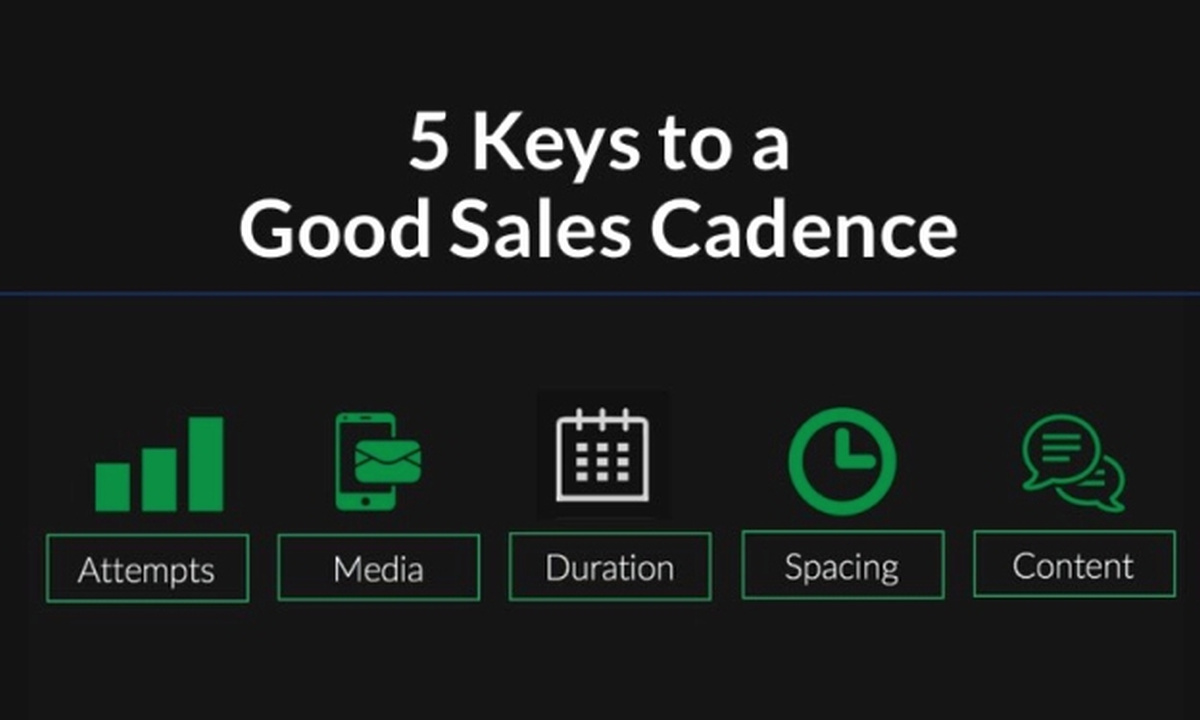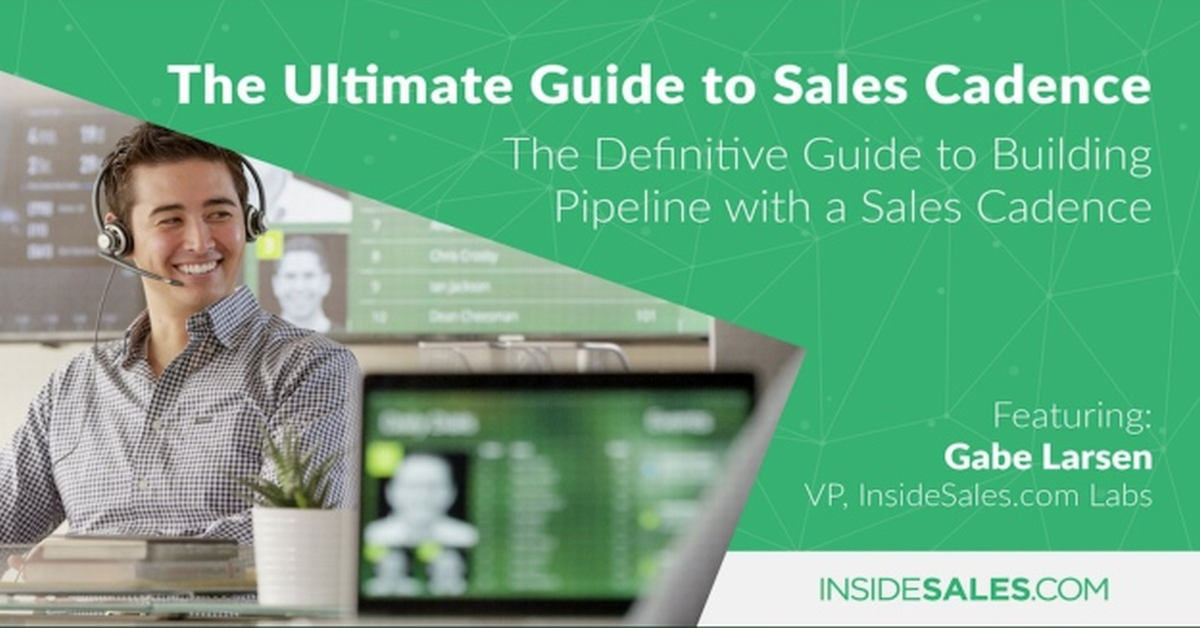The 5 Step Process To Building A Sales Cadence That Works
Building a sales cadence shouldn’t be rocket science — it should be in the arsenal of every decent, hard-working sales rep. This should be the case even if it’s just to spite Marketing that your part of the bargain is held. In this post, I’ll give you all the elements you need to design your own successful sales cadence.
In this article:
- Generating Inbound Leads
- Why Do You Need To Build a Sales Cadence?
- The Foundational Elements of a Sales Cadence
- What Is Sales Cadence?
- The 5-Step Process to Build a Sales Cadence
- Executing a Sales Cadence Flawlessly
- Compare Your Sales Cadence To That of Fortune 500 Companies
How to Build Sales Cadence That Actually Works
Generating Inbound Leads
There’s a lot to be said about the effectiveness of inbound marketing, and while not all marketing leads are created equal, there’s value in these efforts nonetheless. A Hubspot report shows that Marketing departments produce hundreds to thousands of leads per month (the number will vary by industry). As a sales rep, how do you stay on track with the right sales activities and following up with the right leads, every day of the week? It all starts with a well-thought-out sales cadence.
When implemented correctly, a sales cadence can nearly double your contact rates, show internal experiments from XANT (preliminary data from soon to be published research, if you will. Just know I’m not making this up).
Why Do You Need To Build a Sales Cadence?
Salespeople and sales managers have been selling for years, and many of them don’t give much thought to sales cadence. So, why do you need one? The sales cadence is the sequence of sales activities or a series of activities a sales rep initiates to try and establish contact with a prospect or make a sale with potential clients.
There are two main purposes for having a sales cadence:
- To make sure leads are not falling through the cracks while your team is working in the CRM
- To make sure deals are progressing by moving leads to the next stages in the funnel
Your sales cadence can also optimize your sales team activities and nearly double their contact rates. But for this, it needs to be customized to your ideal buyers (target audience) and to your product and/or industry.
The Foundational Elements of a Sales Cadence
The foundational structure for a cadence — let’s call it a ‘classic cadence’– is placing 3 phone calls, leaving 3 voicemails, sending 3 emails, and performing 3 social interactions. XANT research has shown that this cadence can produce optimal results, even if you don’t have enough time and resources to refine it and think of a better sales and marketing strategy.
It’s a tried and tested sales cadence, and if you’re just starting out to build out a working sales process, this should be your first step.
When deciding the structure of a cadence you need to review five elements: sequence, attempts, duration, spacing, media, and messaging. Your sales cadence should answer questions for the sales team, like:
- How do I start to engage my prospects?
- How long should I attempt to contact them, before giving up?
- Over the course of how many days should I time my efforts?
- How many days should be in between my sales touches?
- Should I email, call or leave a voicemail?
- What should I say, when I get someone to respond?
What Is Sales Cadence?
A sales cadence is a complex strategy which molds to your target audience needs and can encompass all or some of six communication media: phone, voicemail, text message, social media, email, and direct mailing.
The 5-Step Process to Build a Sales Cadence
So, how do you start to build a proper sales cadence that works to get you opportunities and ultimately closed deals?
Building the Structure of a Sales Cadence
When deciding the structure of a cadence you need to review the six basics and compare them to industry benchmarks. Are doing more or less calls than what the industry is doing? Are your touches spaced out properly for your leads to have time to breathe, without losing top of mind?
XANT Labs research analyzed 14,000+ cadences, made up of 144,000+ total activities, across nearly 9,000 companies and established these five critical components for a successful cadence.
Step 1: Analyze the Attempts
This is the total number of touches in a sequence. In one TOPO study, sales development reps were asked how many total touches they performed on a lead or contact, they reported 15.4 touches across all communication methods.
However, XANT’s study analyzed over 8,000 companies to see what SDR’s really did with their time, the typical lead had only 4.05 touches.
Clearly, sales reps are over-estimating their own activity.
According to an HBR study, you should make a minimum of 6 calls to try and get in touch with leads, and the ideal cadence has between 10 and 15 touches.
Step 2: Figure Out Which Types of Media to Use
Should I call, should I write an email, or leave a voicemail? How about all of them? A healthy sales cadence should use all communication media at your disposal. If you can find out if your clients prefer to email or a phone call — even better, use that to your advantage.
With transactional sales, short sales cycles and small deal sizes, you can use more aggressive mediums such as the phone. If you are a relational sales rep with longer sales cycles and larger deal sizes, you can start with email or social and follow with more aggressive communication like the phone.
Looking for more info on sales cadences? Register for our webinar!
Step 3: Determine the Ideal Duration
Duration is the length of a sales sequence from first touch to last. Again, there is a disconnect between reality and what people think they are doing. Sales development reps think their average duration is around 29.3 days, when it is in fact around 4.8 days.
Research shows that best practice for duration is two to four weeks.
Yep, you read it right. You can’t give up before the two weeks mark, or you will miss out on opportunities.
For relational or account-based reps, best practice indicates those should be executed over a longer time frame depending on the strategy of the initiative. For a transactional or high-velocity rep, the cadence should be shorter, closer to the two business week period.
Step 4: Figure Out the Appropriate Spacing Between Your Activities
How should you space your activities to make sure your prospects get some time to breathe, read your content, or think about your proposal? Most reps will have spacing between 1 and 4 days, with sales reps in the transactional model focusing on shorter time between activities.
Tip: It’s a good idea to keep your spacing consistent for simplicity.
Step 5: Craft Content That Will Speak to Your Customer
What do you say, when you finally get someone on the phone? Do you start off by asking questions about their business, or do you immediately proceed to your sales pitch? Often, the type of business you’re in and the characteristics of your target audience will decide what your message is about.
Research has shown that the typical length of an email is 362 words, and nearly half of voicemails left were over 30 seconds. As always, take industry benchmarks with a pinch of salt. Just because they are doing this, it doesn’t mean that it works.
A Boomerang study in 2016 put the ideal length of an email at 50 to 125 words.
Remember, your content will only work if it speaks to the pain points of your customer. Always, always start with your customer and know your personas.
Executing a Sales Cadence Flawlessly
Finally, planning is important, but execution will eventually determine how successful your sales cadence is. Derek Boggs, Marketing Automation Manager at XANT, has executed over 900 Account-Based Sales campaigns. He shares his tips for a killer sales cadence:
“A successful sales cadence requires two things. First, it requires timely follow up to a recent engagement or trigger. You need to respond to a need or a shared experience that recently happened. Whether it is a direct mail piece landing on their desk, they clicked on a link in an email, or they just got promoted at their company — it is important that your next message references that trigger and is timely to that event,” said Derek.
“Second, your messaging should be consistent to the event that triggered the sales sequence and that the offer is the same throughout the execution. For example, if you send a coffee mug through the mail with the offer of getting a demo and see how you can keep your pipeline ‘hot and full’, your emails and phone calls should reference your coffee mug,” adds Derek.
Compare Your Sales Cadence To That of Fortune 500 Companies
What is your sales team doing to get in touch with prospective clients and create more opportunities? You can compare your business sales cadence with what of Fortune 500 companies, with the XANT Sales Cadence Audit.
This is a simple 3-minute survey which allows our research analysts to look at your cadence and compare it to industry benchmarks– and give you detailed information about where you rock and where you can do better.
How good is your Cadence? Dare to take the test?
A successful sales cadence doesn’t happen overnight, but with the right elements and proper execution, it can definitely improve the performance of your sales team. From opening up opportunities to increasing closed deals, a well-designed sales cadence can definitely bring many benefits to your team.
What are your thoughts in building a good sales cadence that works? Share it with us in the comments section below.
Up Next: Why Sales Reps Spend So Little Time Selling
Editor’s Note: This post was originally published on February 8, 2018, and has been updated for quality and relevancy.




